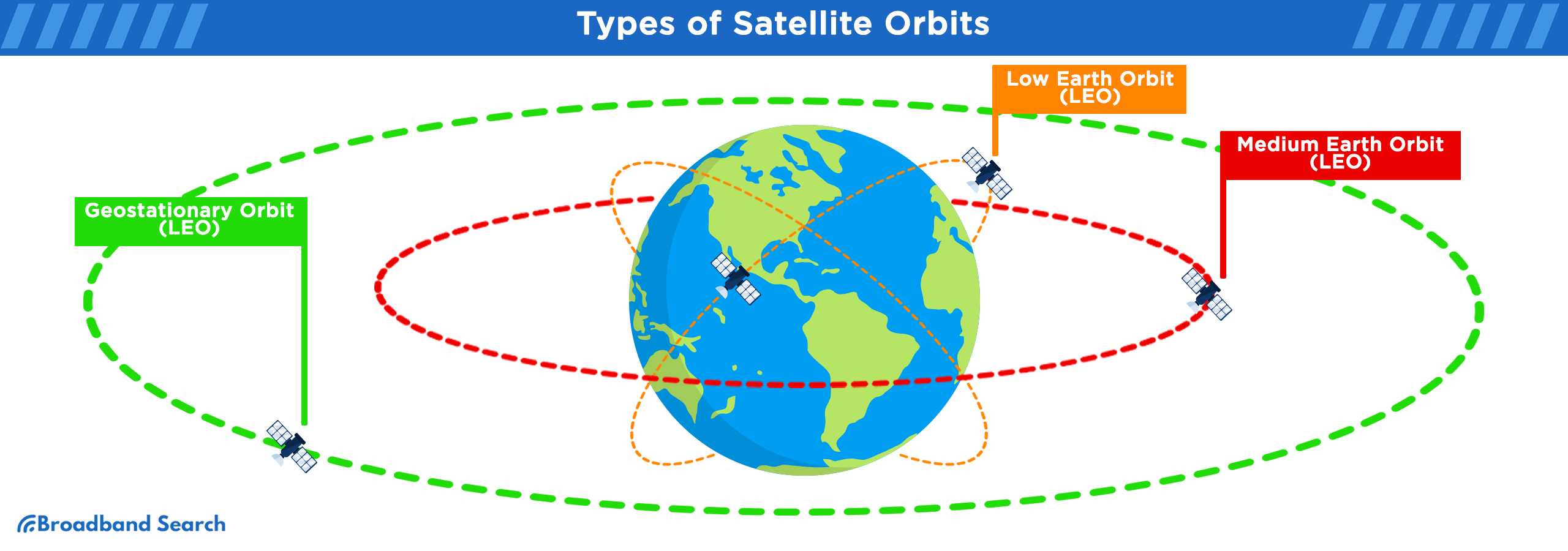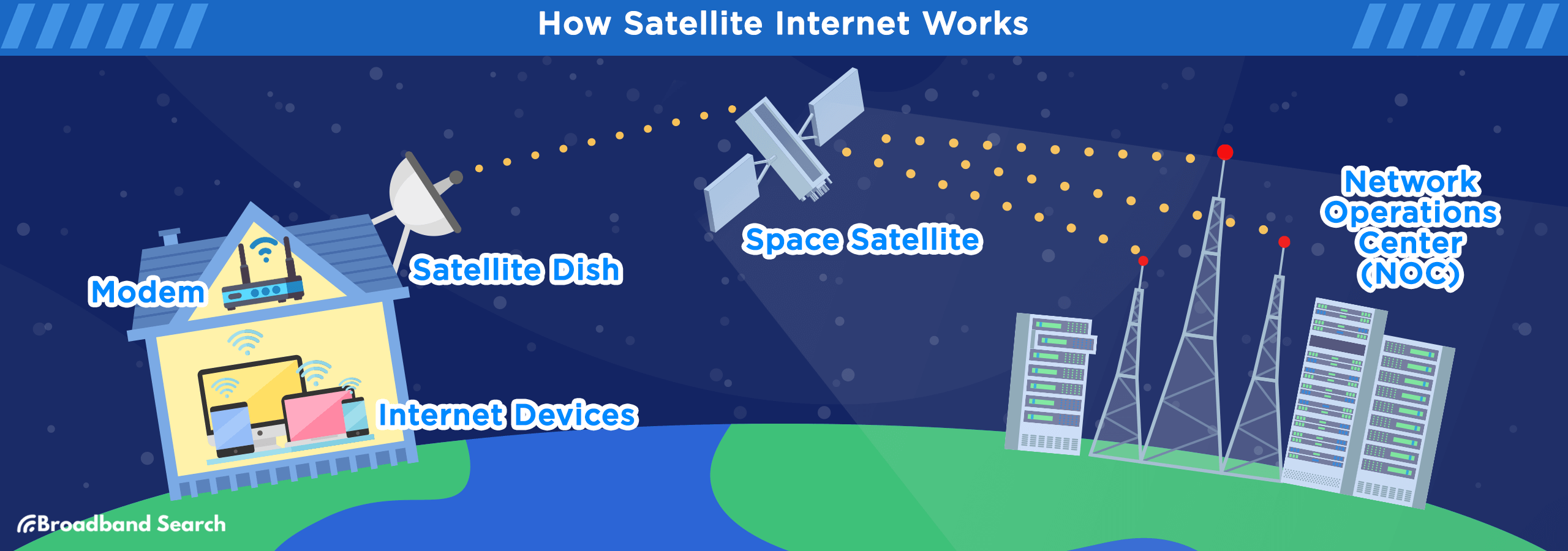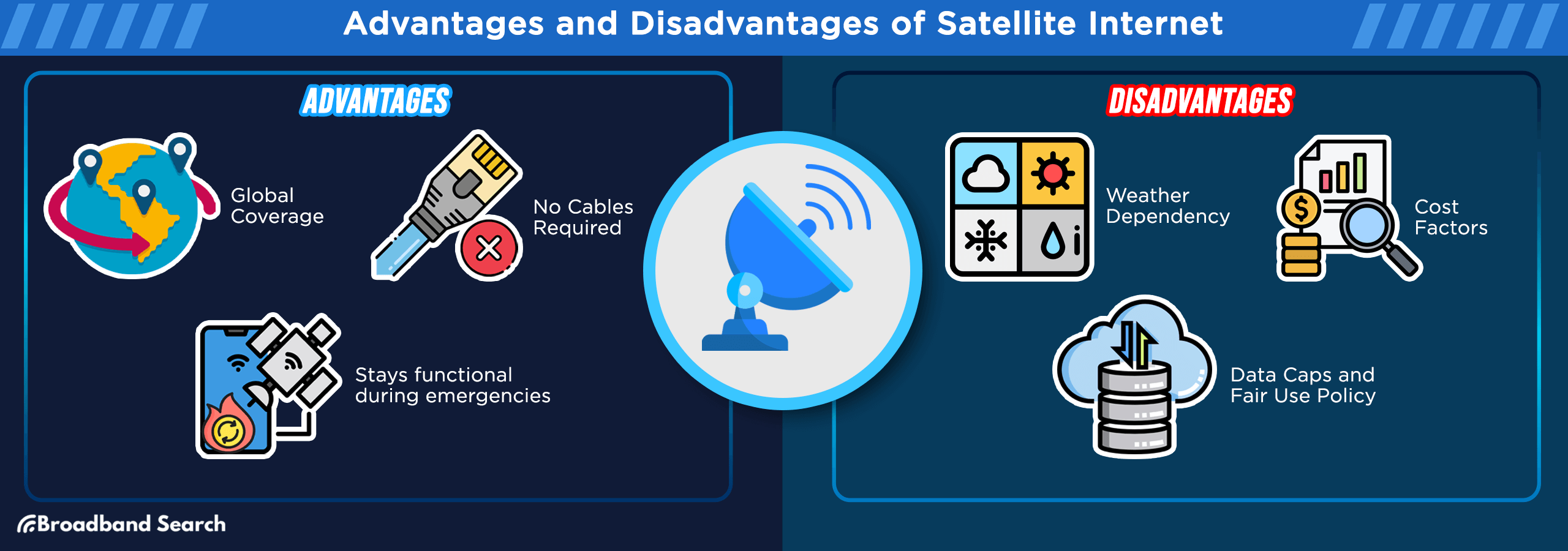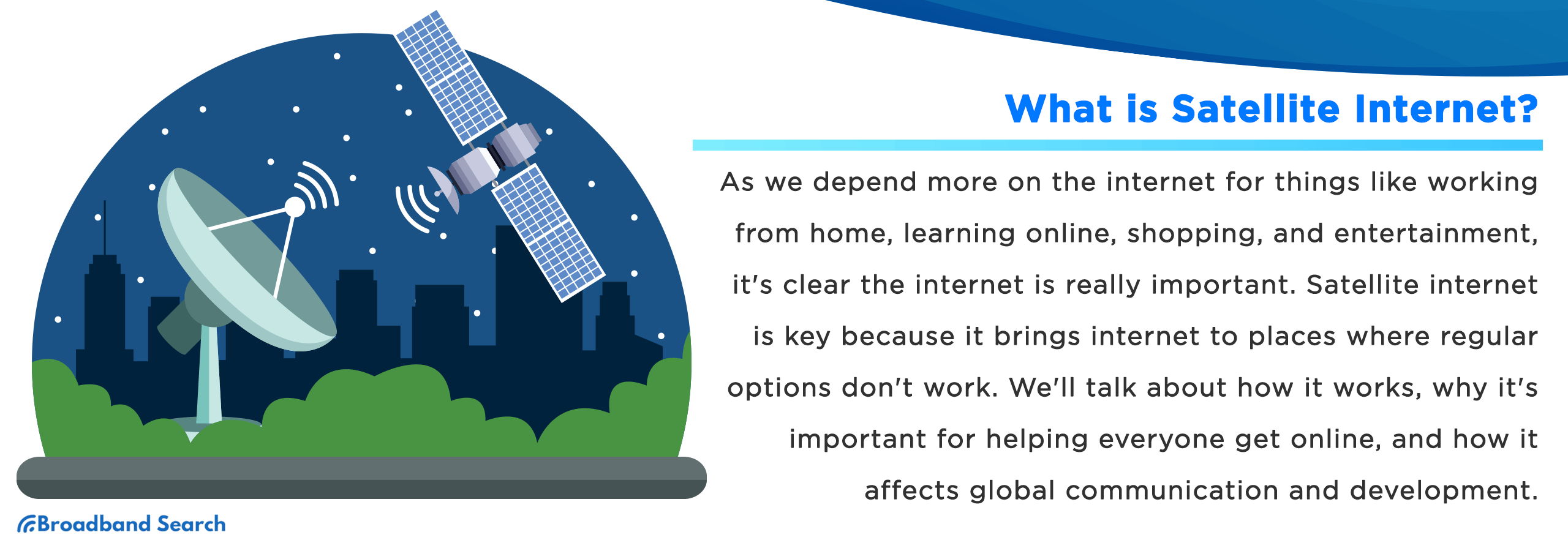More and more aspects of our daily lives are becoming dependent on the internet. From online education and remote working to e-commerce and entertainment, the internet is a cornerstone of modern society.
In this context, Satellite internet emerges as vital. It extends internet access to remote and underserved areas where terrestrial internet options are not feasible. To help inform you about this option, we aim to explore the mechanics of satellite internet, its importance in bridging the digital divide, and its impact on global communication and development.
Understanding Satellite Internet
Satellite internet works by using radio waves to communicate with satellites orbiting Earth. This process starts with your device sending data through your modem and satellite dish to a satellite in space. The satellite then relays this data to a ground station, known as a network operations center (NOC), which is connected to the internet.
The NOC processes your request and sends the required information back through the satellite to your dish, and finally to your device. This system uses a five-part relay involving your internet-ready device, modem/router, satellite dish, satellite in space, and the NOC.
Historical Evolution
The historical evolution of satellite internet is a journey marked by groundbreaking technological advancements and ambitious ventures.
- 1960s: The US Department of Defense explored using satellites for data transmission. In 1962, Telstar 1, the first satellite communication system, was launched, enabling transatlantic television signal transmission.
- 1996: Hughes Network System (HNS-1) was the first satellite to offer Internet services. Launched by Hughes Network Systems, a subsidiary of Hughes Electronics (later acquired by DirecTV), it provided two-way internet access in North America using small satellite dishes.
- Early 2000s: Teledesic, Iridium, and Globalstar launched satellites for global broadband Internet access. These ventures, however, failed due to technical challenges, high costs, and limited demand.
- 2005: WildBlue Communications launched a satellite Internet service in the United States, focusing on high-speed Internet access in rural areas not covered by traditional broadband providers.
- 2008: ViaSat acquires WildBlue and later introduces the Exede-branded satellite internet service.
- 2015: SpaceX announced its plan to deploy thousands of low-earth orbit (LEO) satellites for the Starlink network, aiming to provide high-speed, low-latency internet services globally. The first Starlink satellites were launched in 2019.
- Recent Developments: Other companies like OneWeb, Amazon Project Kuiper, and Telesat are also planning to launch their own LEO satellite constellations to offer global Internet access.
Components of Satellite Internet

Satellite internet relies on several key components to provide high-speed internet access to users. Here are the essential components:
Satellites
Satellites are naturally used in satellite internet, but satellites themselves may differ. The easiest way to classify the differences is to talk about their intended orbit:
- Geostationary Earth Orbit (GEO): Satellites in geostationary Earth orbit, positioned 35,786 kilometers above the equator, are strategically placed directly above Earth's equator. This high altitude allows just three satellites, spaced evenly in GEO, to provide almost complete global coverage due to their extensive reach over the Earth's surface. Since it is situated directly above the equator, broadcasting to the polar regions becomes challenging; the increased transmission distance results in a significantly weakened signal reception.
- Medium Earth Orbit (MEO): Medium Earth Orbits (MEO) are located 5,000 to 20,000 kilometers above the Earth's surface. Notable satellites in this range include the GPS and Galileo Satellite constellations, crucial for global navigation. The signals from MEO are weaker upon reaching Earth compared to those from LEO, primarily because MEO is at a higher altitude than LEO. Consequently, increased transmit power is required to counteract path loss and atmospheric attenuation.
- Low Earth Orbit (LEO): These satellites are closer to Earth's surface, typically below 1000 km, with some orbits as low as 160 km. LEO satellites can follow various paths, not limited to the equator like GEO satellites, offering more flexibility. Due to its closer proximity to Earth, a LEO satellite covers a smaller area, necessitating a larger number of satellites for global coverage, making LEO-based systems expensive to install.
Ground Equipment
The ground equipment essential for satellite internet includes satellite dishes, modems and routers, and ground stations, each playing a critical role.
- Satellite Dishes: These are key components for both receiving and sending signals to the orbiting satellites. They are typically parabolic in shape or may use flat-panel phased-array technology. The dishes focus and direct radio signals toward the satellite. In systems using LEO satellites, the dishes might have advanced tracking mechanisms to maintain a stable connection.
- Modems and Routers: These devices are necessary for converting digital data from users into signals that can be transmitted to the satellite and vice versa. The modem is responsible for converting incoming and outgoing signals, while routers distribute the internet connection wirelessly within the user's premises. Some systems might integrate both functions into a single device.
- Ground Stations: Also known as gateways or Earth stations, ground stations are critical for the satellite internet infrastructure. They are equipped with high-performance antennas and radio frequency equipment to communicate with satellites. Ground stations receive signals from the satellite, convert them into digital data, and connect to the internet backbone, usually via fiber-optic cables.
Network Infrastructure
- Data Centers: Data centers are specialized warehouse facilities housing the computing infrastructure and network connections essential for internet and cloud services. They host critical network components like switches and routers, managing data traffic for various digital communications, including streaming services.
- Backbone Connections: The internet backbone consists of high-capacity communication lines crucial for network connections across regions and countries. Acting as a central data pathway, it connects different networks for seamless communication.
How Satellite Internet Works

Technical Process
The technical process of how satellite internet works involves several key steps, from signal transmission and reception to data routing through space and ground networks.
- User Data Request and Uplink Transmission: When a user makes a data request, this request is sent from their device to a satellite modem connected to a satellite dish at the user's location. The modem converts this request into digital signals, then transmitted to a satellite in orbit.
- Satellite Reception and Relay: The orbiting satellite receives and processes these signals. It then relays the signals back towards Earth, targeting a ground station, also known as an Earth station or teleport.
- Ground Station Reception and Data Routing: The ground station receives the signals from the satellite. It converts the signals back into digital data. The ground station, connected to the internet backbone via wired connections like fiber-optic cables, routes this data through the internet network to retrieve the requested information.
- Downlink Transmission and Final Delivery: Once the requested data is located and retrieved, it's sent back to the ground station. The station then converts this data into radio signals and transmits them back to the satellite. The satellite receives these downlink signals and relays them back towards the user's location. The user's satellite dish receives these signals, and the modem converts them back into digital data. Finally, this data is sent to the user's device, completing the request.
Bandwidth and Data Speeds
Factors Affecting Speed and Reliability
- Distance from the Satellite: The distance data has to travel to and from the satellite significantly affects latency. The farther the data travels, the more latency is experienced. This is particularly notable with geostationary satellites positioned much further from Earth than low Earth orbit (LEO) satellites.
- Weather Conditions: Satellite internet is susceptible to disruptions from atmospheric conditions. Heavy cloud cover, storms, and severe weather can interfere with signal transmission, leading to slower speeds or temporary outages.
- Network Congestion: Similar to other types of internet services, satellite internet can experience slower speeds during times of high network usage. If too many users are accessing the satellite simultaneously, it can lead to congestion and reduced performance.
Advantages of Satellite Internet

Satellite internet offers several advantages, making it a valuable technology for various applications. Below, we briefly highlight some key benefits of satellite internet.
- Global Coverage: It is accessible in remote and rural areas. It can provide connectivity across the globe, including in areas that cables cannot reach.
- Disaster Recovery and Emergency Services: Satellite systems will often stay functional during an emergency. This resilience is crucial for coordinating rescue efforts, effectively allocating resources, and ensuring ongoing communication among emergency responders, command centers, and other critical entities.
- No Cables Required: Satellite internet is valued for its independence from ground infrastructure.
Challenges and Limitations
While satellite internet offers valuable connectivity in remote areas, it also comes with several challenges. These limitations can affect the user experience and make it less ideal for certain applications.
- Weather Dependency: Satellite internet can be impacted by atmospheric conditions. However, these weather-related issues are generally brief and infrequent. Newer satellite technologies, like Viasat's ViaSat-3, are designed to be more resilient to weather impacts.
- Cost Factors: The initial setup and ongoing costs of satellite internet can be higher compared to other internet services. The complex equipment, such as satellite dishes, and the service plans are often expensive. In the United States, the typical monthly expense for a satellite internet subscription is around $110. The cost is a significant factor, especially when comparing satellite internet to wired options like cable or fiber optic internet.
- Data Caps and Fair Use Policy: Satellite internet often comes with data caps, limiting the amount of data a user can consume each month. Exceeding these caps can result in reduced speeds or additional charges. This limitation can impact users who require heavy internet usage, such as for streaming or large downloads.
Recent Developments and Future Trends
Technological Advancements
Technological advancements are continually reshaping our world, driven by rapid innovations across various sectors. These developments not only enhance existing processes but also pave the way for new possibilities.
- Expansion into Cloud and Edge Computing: Current trends in satellite communications include extending capabilities into cloud and edge computing.
- Military and Defense Applications: Satellite IoT is increasingly used in military and defense, offering solutions to overcome terrestrial network limitations in extreme environments.
- Hybrid Satellite-Terrestrial Services: Emergence of hybrid services that combine satellite IoT with terrestrial networks, enhancing overall infrastructure robustness.
- Integration of Machine Learning and AI: Crucial for analyzing satellite data, particularly in earth observation (EO), global navigation satellite systems (GNSS), and remote sensing, AI-driven data analysis is becoming increasingly important.
- Ground-Station-as-a-Service Solutions: Ground stations are employing AI for satellite management and optimization.
- AI in Orbit Operations: In orbit, AI aids in real-time orbit prediction and satellite tracking, which is essential for improved space traffic management.
Expanding Access and Adoption
The expansion of satellite internet access is driven by global initiatives, technological innovations, and market trends. In the United States, initiatives like those from the FCC and companies like Viasat are making low-cost satellite internet more accessible in rural areas, fostering economic growth and improved connectivity.
Private investments in companies like SpaceX and OneWeb are also crucial, covering infrastructure costs and supporting the development of satellite internet technologies.
The Takeaway
We see a significant shift towards digital inclusion because satellite internet is transforming connectivity, especially in underserved rural and remote areas.
This change is fueled by technological advancements that make internet access more affordable. Additionally, government initiatives and private investments play pivotal roles in this expansion, aiming to bridge the digital divide and enhance access for all.
These advancements promise to connect even the remotest areas to the digital world, making satellite internet a key player in the global effort to ensure universal internet access, supporting economic growth, and empowering communities worldwide.
FAQ
Is there a contract required for satellite internet?
Whether a contract is required for satellite internet service largely depends on the provider, though it is the typical process. It's essential to check with specific providers to understand their contract requirements and terms.
Can I use satellite internet on a boat or in an RV?
Yes, satellite internet can be used on boats or in RVs. Mobile satellite internet solutions are designed to provide reliable connectivity in such scenarios, though the equipment and plans might differ from standard home satellite internet services.
How does satellite internet support remote work?
Satellite internet supports remote work by providing internet connectivity in locations that may not have access to other forms of broadband. With advancements in satellite internet technology, the improved speeds and reliability make it a feasible option for various online work-related activities.
What troubleshooting steps are available for satellite internet?
Common troubleshooting steps for satellite internet issues include restarting the modem, checking for obstructions that might block the satellite dish, and ensuring that all cables are securely connected. For more complex issues, contacting the service provider's customer support is recommended.
Can I get unlimited data with satellite internet?
You may be able to get unlimited data with satellite internet, but it varies by provider. Some providers may offer unlimited data plans, but these plans could be subject to data policies like throttling. Review the plan details and understand any limitations associated with unlimited data plans.

